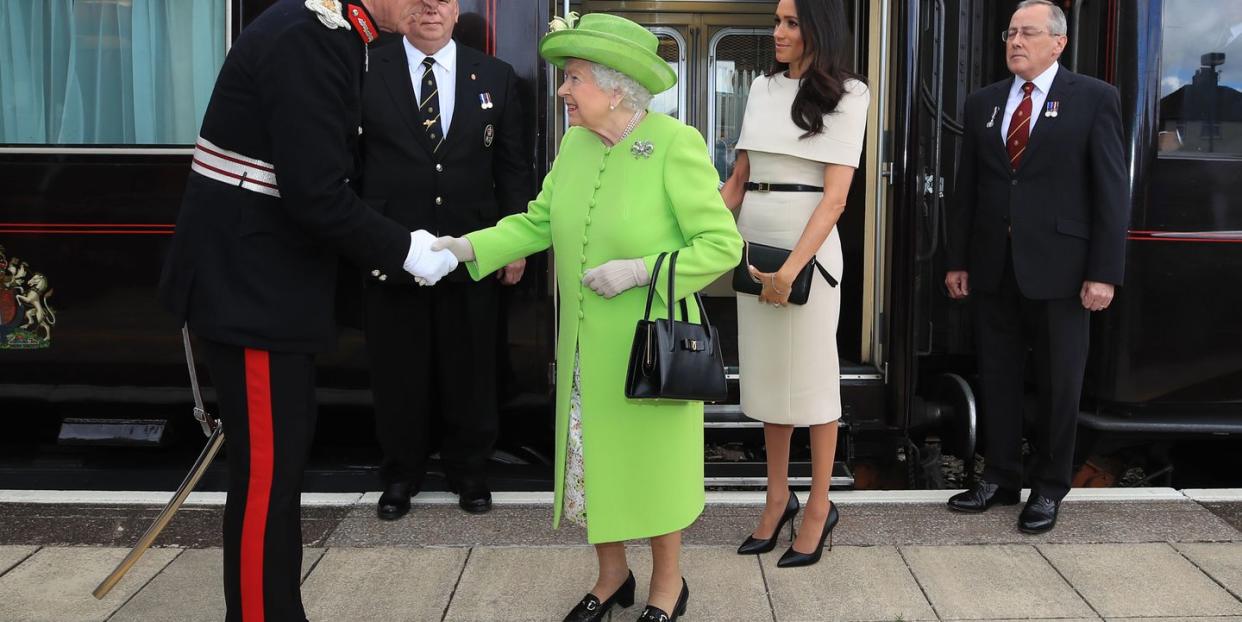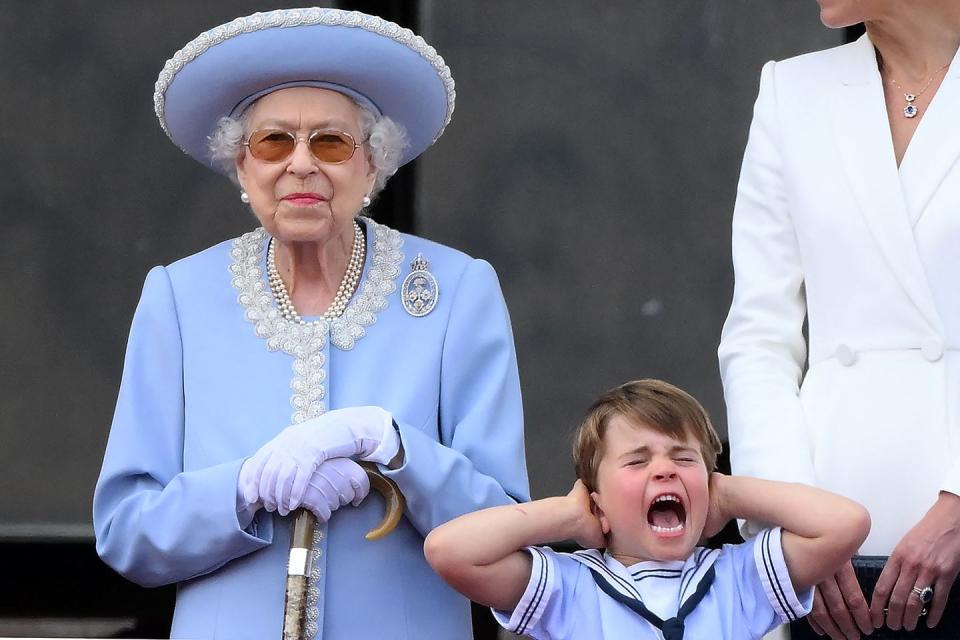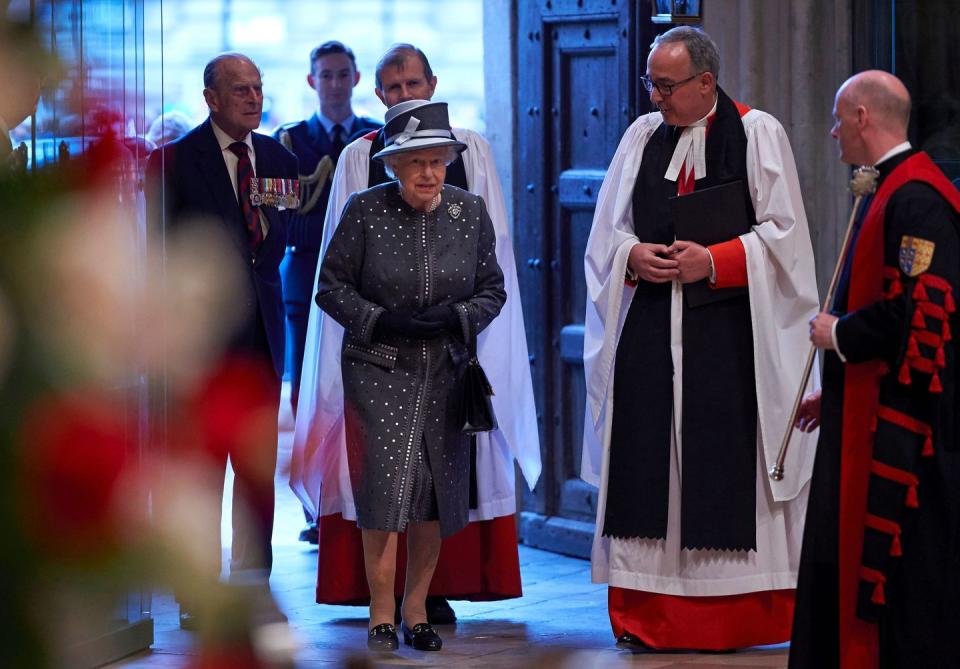The Colorful Paradox of Queen Elizabeth's Style

- Oops!Something went wrong.Please try again later.
"Hearst Magazines and Yahoo may earn commission or revenue on some items through the links below."
When I think of figures who wear the same outfit over and over to brilliant effect, two names come to mind: Karl Lagerfeld and the Queen of England.
Uniforms are the surest way of expressing power through clothes. Seeing a person in the same outfit over and over fixes them in your mind; the flush of visual cues becomes codified into expressions of that person’s most deep-seated values. Lagerfeld, with his ruffled blouses tucked into Hedi Slimane’s skintight jeans, wanted us to see him as a 19th century gentleman-snob yanked gleefully into these sexy modern times to tell us what’s chic.
And the Queen, with her simply cut frock coats and matching pastel skirt suits, was both a symbol of joy and a fascinating embodiment of every monarch’s ultimate challenge, which is to stay exactly the same while changing with the times. The Crown has taught us all that a royal is meant to say or give away very little, but of course the Queen said a lot with her clothes—in fact, she rivaled Diana in her mastery of the tell-all outfit. Even her standard suite of accessories had stories to share. Whether she was wearing a gray ribbon-trimmed ensemble for a military remembrance in 2016, a warm lime green coat to celebrate the opening of a new bridge in 2018, or a pale blue jacket with pearly trim for Trooping the Colour in 2022, her outfit was always completed with a coordinating brooch that recalled an earlier moment in British history, a little black handbag that she used to signal to her aides, and a pair of black shoes broken in by her dedicated dresser, Angela Kelly.
Queen Elizabeth, who died on Thursday at the age of 96 after an almost incomprehensible 70-year reign, used the uniform to insist that her appearance should be a source of simple happiness even as it oversaw nearly a century of rapid advancement and turmoil. I don’t believe I’m alone in feeling that her most indelible image is not one of an aloof, velvet-gowned idol in a bejeweled crown, but rather a woman smiling pleasantly in a tasteful coat, sensible shoes, and gloves. Who knows if she craved human contact, but the point was that she made it the centerpiece of her reign: as she put it, “I have to be seen to be believed.” And when she was seen, it was meant to make you feel good.
Yes, she pioneered sartorial diplomacy, having Norman Norell or Hardy Amies or, since the early ’90s, her dresser and designer Angela Kelly whip up a suit in the color of the country she was visiting as a gesture of goodwill. Many of these things she did in part because she lived for so long; how else to communicate through such rapidly changing political relationships? It’s difficult to conceptualize how long her rule was, no matter how much of it you yourself have witnessed: she became Queen shortly after World War II, oversaw The Troubles and the decline of British colonial rule, and in her final years, maintained her symbolic role as Britain’s leader during Brexit and Covid.

She wasn’t a clotheshorse (unlike her son, now King Charles III, a devotee of the trendy stylings of Savile Row suit makers Anderson & Sheppard who, pending the national mood, could usher in a new era of sartorial splendor or face accusations of frivolity). But she clearly loved the fun of clothing, and even milked the distinctly British approach to style as a thing of joy with festively trimmed hats and a commitment to vivid, head-to-knee monochrome outfits. Maybe her clothes are one of the few moments when we see a sense of essentially feminine indulgence, or perhaps they are a diligent insistence that the crown represents something despite political evidence to the contrary. The force of royal style is that both readings are valid.
But her uniform most clearly embodies the complicated feelings that the passing of this figure inspires: reverence, conflict, awe, sadness. Her uniform, crucially, was never a costume: she truly seemed to believe in every garment she put on. Of course, the strictures of her role meant that she could never follow or indulge in fashion, even if she might float adjacent to it by sitting front row at a Richard Quinn show, as she did in 2018. But she also could have easily clung to the styles of her golden age, as her mother often did, and represented a connection to a time when England’s power was at its zenith. Instead, she made minute but just-perceptible changes that showed a quiet acceptance of a changing world: skirts became more streamlined, shoes became more practical. For the most part, though, her clothes from 20 or 30 years ago look identical to those she wore in this more current time. As a result, she appeared tethered to her own view of the universe, carefully balancing something “classic” with something acceptably modern. The world may change around her, and she may adapt to some of these changes, her clothes told us, but for the most part, she would lead not as a maverick but as a reminder that some things never change. That can be chilling, or a comfort. The Queen’s sartorial power was that both were true.

She oversaw the first royal divorces, the arrival of the first Black woman in the Royal family, the younger generations dispensing with everything from pantyhose to royal duties themselves; not to mention the tumbling of the monarchy into disgrace after her son Andrew disgustingly entangled himself with Jeffrey Epstein. She knighted rock stars and supermodels. But she did it all in the same clothes. Even if she was dressed in clothes we’ve seen for half a century, their insistence took on more and more meaning as the years went on, even as she repeated outfits.
What will be the legacy of this singular mode of uniform dressing? Younger royals have been more eager to show their commitment to society’s progress with their clothes. Prince Harry’s skinny suits, for example, are often held up as an example of his more populist empathies because they mostly come from J. Crew, but they also look trendy in a way his grandmother's clothes never could. It was Diana who got us into the business of paying attention to designer names, silhouettes, and colors, and what they might “mean”; even her haircut was a cipher. The cottage industry of photoshopping side-by-side images of Meghan Markle or Kate Middleton wearing even the same color as something Diana once wore remains a thriving one.
Contemporary mores, the media blitz around the royals set into motion decades ago by Rupert Murdoch, and frankly, the specter of Diana, mean that we know things about the new King and his children that we never would have even dreamed of speculating about the late Queen. There are rumors about sexual proclivities and affairs and transcripts of explicit phone calls that will either doom this era before it even begins or represent a brave new period of more open and realistic relationships. Amid the swirls of gossip and conjecture, you can read the entire fracture of the Royal family through their style: Meghan in the Net-a-Porter-fresh wardrobe of a Californian new media disruptor; Kate in her floral repeats and her graceful way of wearing Alexander McQueen; Harry in his trendy slim-cut suits; and Charles, resolute in his rare sense of personal style. And in the center of them all, Queen Elizabeth, in her glaring, bold, grinning bright coats.
You Might Also Like

